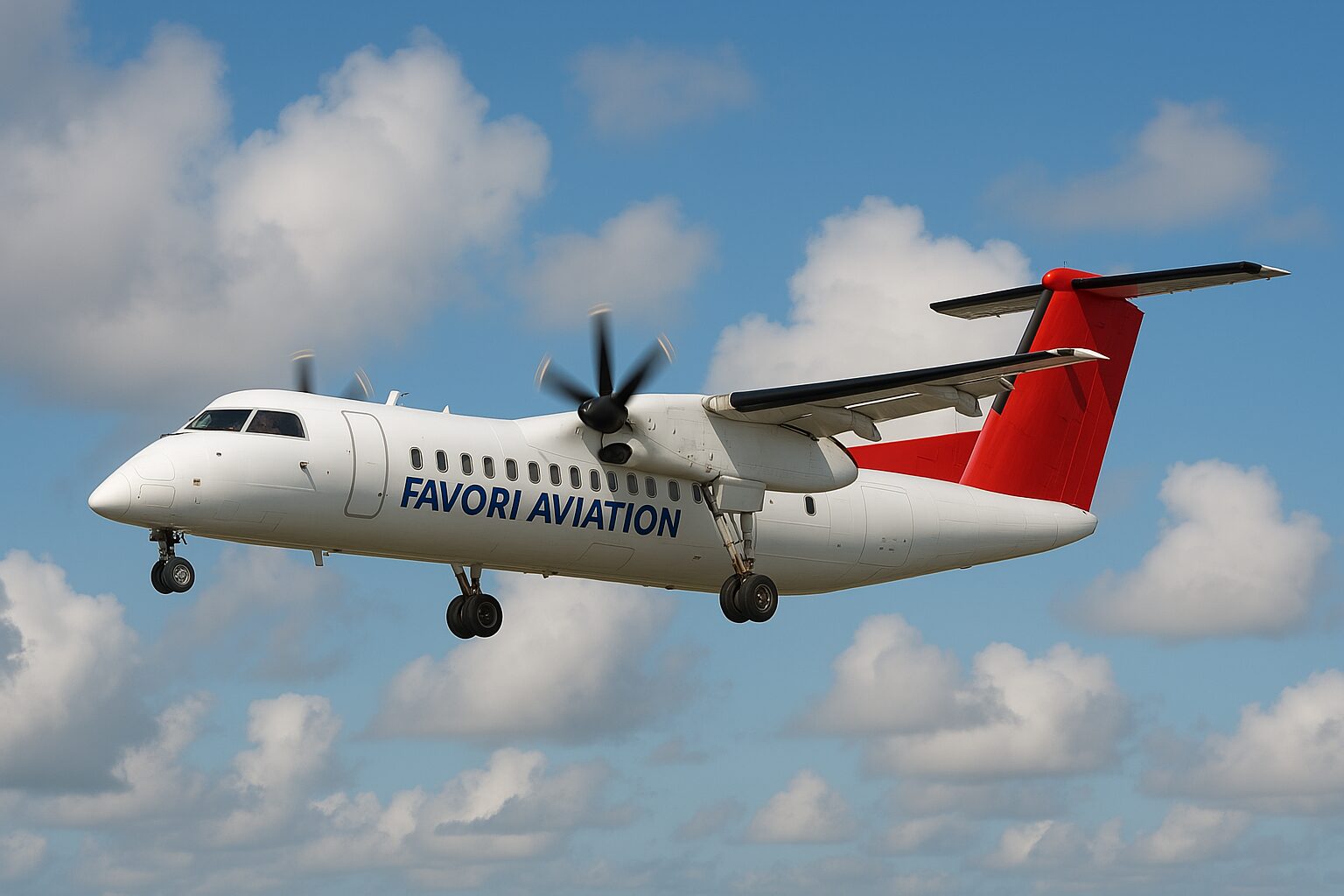Flight UN-684 | Registration: 5Y-SMJ
Date: 1 April 2025 | Location: Aden Adde International Airport (HCMM), Mogadishu, Somalia
Introduction
On 1 April 2025, a Favori Aviation de Havilland Dash 8-400, operating flight UN-684 on behalf of the United Nations, was forced to return to Mogadishu shortly after departure following a critical nose gear malfunction. The aircraft, registration 5Y-SMJ, was en route from Mogadishu to Baidoa with 22 people on board when the crew reported a failure to extend the nose landing gear.
The crew initiated a return to Mogadishu’s Aden Adde International Airport and performed a nose gear-up landing. The aircraft touched down on its main landing gear before the nose made contact with the runway surface. Emergency evacuation was successfully completed, with only one minor injury reported among the passengers.
The aircraft, operated under the United Nations Support Office in Somalia (UNSOS), was transporting personnel between UN bases. The incident is under investigation by Somali aviation authorities in coordination with the United Nations.
Flight Details
• Aircraft Type: de Havilland Canada Dash 8-400 (DHC-8-Q400)
• Operator: Favori Aviation (on behalf of UNSOS)
• Registration: 5Y-SMJ
• Engines: 2 × Pratt & Whitney PW150A
• Flight Number: UN-684
• Callsign: United Nations 684
• Departure Airport: Mogadishu Aden Adde International (HCMM), Somalia
• Destination Airport: Baidoa Airport (HCMB), Somalia
• Date of Incident: 1 April 2025
• Occupants: 22 (including crew and UN personnel)
• Phase of Flight: Initial Climb / Return / Landing
• Time of Landing: Shortly after take-off (exact time not released)
• Weather Conditions: VMC (Visual Meteorological Conditions)
• Runway in Use: 05/23 (Mogadishu)
Sequence of Events
Departure from Mogadishu
The aircraft departed from runway 05 at Mogadishu on a routine United Nations support flight to Baidoa. During the initial climb, the crew received a landing gear malfunction indication, specifically related to the nose gear.
Decision to Return
Unable to confirm proper extension of the nose landing gear, the flight crew declared an emergency and made the decision to return to Mogadishu. Air traffic control granted priority handling, and emergency services were placed on standby.
Emergency Landing
After conducting fly-bys for visual confirmation and attempting standard and alternate gear extension procedures, the crew proceeded with a nose gear-up landing on runway 23. The aircraft landed on the main gear before lowering the nose onto the runway in a controlled manner.
The flight crew maintained directional control throughout the landing roll. The aircraft came to a complete stop on the runway, and an immediate evacuation was initiated.
Emergency Response & Evacuation
The evacuation was carried out promptly. Emergency services responded on site and assisted with passenger disembarkation. One passenger sustained a minor injury during the evacuation process, while all other occupants were unharmed. The aircraft sustained damage to the lower forward fuselage and nose radome as a result of the gear-up landing.
UNSOS and Favori Aviation both confirmed that the crew executed the emergency procedures with professionalism, minimising risk to life and property.
Operator & Aircraft Background
Favori Aviation, a charter operator contracted by the United Nations for humanitarian and peacekeeping support missions, operates multiple regional turboprop aircraft including the Dash 8-400. Aircraft 5Y-SMJ is a high-cycle platform typically used for intra-Somalia and East African relief and logistics flights.
Technical Considerations
Landing Gear Failure
Initial reports suggest a mechanical or hydraulic fault prevented the extension or locking of the nose gear. It is currently unknown whether the issue originated in the gear actuator, proximity sensors, or electronic control systems.
The Dash 8 Q400 is equipped with both normal and alternate landing gear extension systems. The inability to lower the nose gear even via the alternate method indicates a possible mechanical failure or blockage in the nose gear bay.
Aircraft Performance
The Q400 is structurally capable of executing gear-up landings on its nose due to its high-mounted engines and reinforced lower fuselage. In this case, proper pitch control and speed management by the crew prevented further damage.
Official Statements & Investigation
United Nations (UNSOS Statement)
UNSOS confirmed the aircraft was on a regular personnel transfer mission. A spokesperson praised the crew’s decisive actions and reported that only one individual sustained a minor injury. The UN is supporting the ongoing investigation.
Somali Civil Aviation Authority (SCAA)
The SCAA acknowledged the event and confirmed that a formal investigation has been launched to determine the root cause of the gear failure. Preliminary assessments suggest a technical malfunction as the probable cause, with no indication of external interference or pilot error.
Favori Aviation
The operator stated that safety protocols were followed precisely and commended the flight crew for managing the emergency under pressure. Maintenance inspections are underway, and the aircraft will remain grounded pending further investigation.
Aftermath & Operational Impact
• Runway Closure: Aden Adde International Airport temporarily suspended operations to accommodate emergency services and aircraft recovery.
• Aircraft Status: Aircraft 5Y-SMJ remains grounded and will undergo detailed structural and systems inspection.
• Replacement Flights: UN operations out of Mogadishu are expected to resume using alternate aircraft.
• UN Response: A full internal review is being conducted by UNSOS to evaluate emergency preparedness and coordination effectiveness.
Summary & Safety Outlook
This incident underscores the importance of emergency training, particularly for missions operating in remote or high-risk environments such as Somalia. The crew’s calm and methodical response averted a potentially catastrophic event and demonstrated a high level of professionalism.
While damage to the aircraft is being assessed, no serious injuries were sustained, and the majority of passengers and crew were unharmed. Investigation findings will be key to preventing similar nose gear failure scenarios in the future.
Disclaimer
This report is based on publicly available information and official statements as of 2 April 2025. Further updates will be provided as the investigation progresses. If you are the rightful owner of any referenced content and wish for it to be removed, please email takedown@cockpitking.com.
